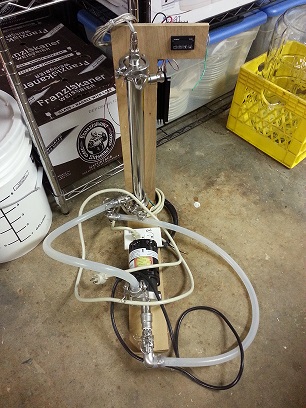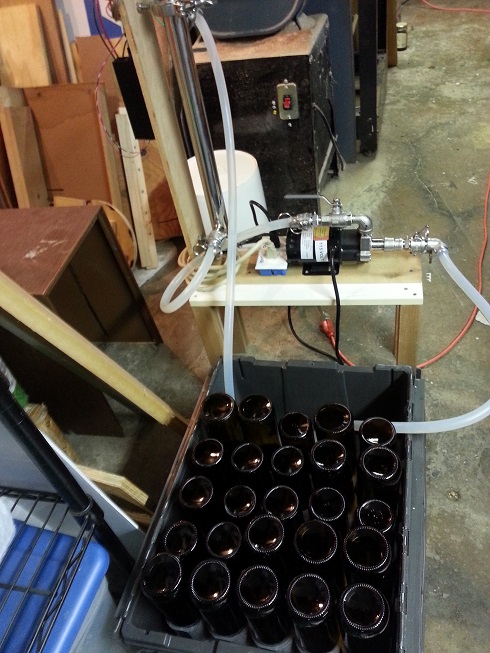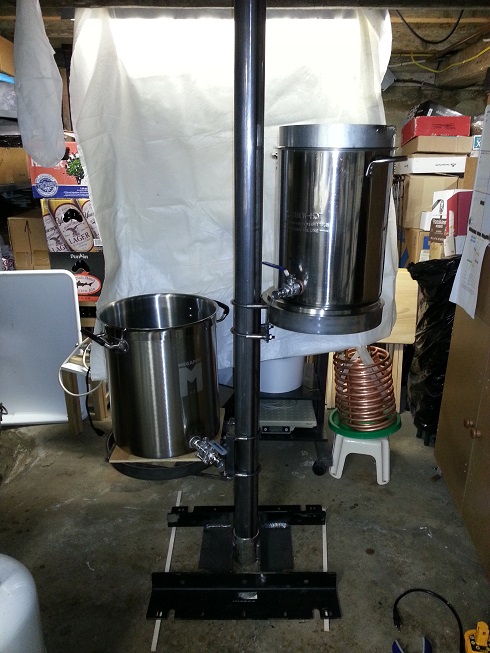I keep teasing people with brief posts about my DIY projects with comments in other threads, and its time to break loose with the details, starting with an introduction. (I had 'brief introduction' initially, but had to remove brief!)
I've been brewing just about 2 years now, and did extract for the first 18 mo or so. I started on the stove, then bought a fully stainless turkey fryer setup to do full volume boils. Well that lead to BIAB(ag), and now BIAB(asket).
Along the way I've made a variety of DIY projects, starting with a ST1000 controlled RediWhip cooler for lagering, then a heated 4 chamber fermentation cabinet, various small volume carbonation bottles/keg, and most recently moving toward electric brewing. And a bunch of things in between.
My biggest challenge is space. I have a comfortably small house with a full basement (but only for the height challenged), and no garage. So, many of my projects have been designed to maximize the available space in the basement, starting there with a extra deep sink (with below grade pump) a counter and storage. Having a small family manufacturing business helps immensely as I have lots of tools at my disposal. A shear, finger/box break, welding, brazing, and soldering equip, plus a milling machine and metal lathe all come in handy. Oh, and being a DIY'r for most of my 54 yrs helps too. I don't hire contractors for my house as I do it all myself (except the roof and sewer line I will admit), and I can rebuild engines and old wooden boats, and I can melt bronze into new shapes - but I digress.
One thing I need to admit to is that I'm 'online challenged'. Put me in a corporate datacenter and make be design and implement backups, replication and disaster recovery and I'm at home. Make me manage and post pictures online and I start coming up short. Social media, sorry, can't do that either. So bear with me while I try to post my project stuff. My computer experience goes all the way back to the early 80's (non-stop) but I'm not keeping up with the times very well. And don't be surprised if I'm MIA for days at a time here. I do far too much with far too little time (re-read last paragraph!)
I'm going to jump ahead to the project that kind of pushed me to start this post, my Mash Basket, hence the BIABasket thing above. I tried numerous ways to be able to rinse my grains in the BIABag and just was not happy with any of them. I could have gone with a typical cooler as a mash tun, but what would the fun be in that? Plus that pesky low clearance in the basement. While I'm sure plenty of people make really great beer with BIAB and no rinse/sparge methods, I wanted to step it up a little. I'll leave the pics to the end as that the only way I know how to post them right now. Gotta learn about those new fangled online picture sites for inline picture posts. Any suggestions?
Getting on to the first project - the Mash Basket.
The Mash Basket is a stainless steel sheet rolled into a cylinder and edge soldered. The bottom is a 300 mesh SS screen also soldered in place. With a 12" ID pot a 36" sheet makes a very good fit. I get most of my non-brewing supplies through Mcmaster Carr. You can sometimes find a better price elsewhere but no-one has the selection and delivery they do. I'm close to a warehouse and get most things same day at discounted shipping rates.
I bought a sheet of 304 SS .030 x 36 x 36 for the shell. I cut a 16" piece off of it, then pondered how to roll it into a cylinder. I ended up clamping 1 end to a 5 gallon paint thinner can then set it on a large table (big projects happen in my business shop), and tried to roll the sheet around the can. That went poorly. At .030 thick this stuff is not easy to roll. Eventually I got a little curve going, then found that if I laid on top of it I could push myself back and forth rolling the can and sheet. No witnesses to this, but I'm sure it was a sight to behold. This gave the sheet enough curve to work with. I then clamped a 2x4 across the edge of the table and used it to work the ends of the sheet into the same curve until they sufficiently met. Once I had the basic curve set I cut a circle in a piece of plywood to match the OD I wanted, and slid the cylinder into and clamped the ends at the overlap and started soldering. I used the same solder and flux most everyone here uses.
Once that was done it was onto the screen. Again McMaster supplied this. It's a 300 mesh SS filter quality screen (finer wire than std screen). I cut a 12" or so diameter piece and used the plywood pieces I cut for the cylinder to form a lip around the edge. I put that in 1 end of the cylinder and used the inner circle plywood piece inside to keep it flat in place. May be hard to picture, but I have the pics somewhere..... With the screen inside the cylinder I used a piece of 3/32 SS welding rod formed into as circle on the inside lip of the screen lip to help keep the lip against the cylinder. With much effort, and a few restarts I was able to clamp the rod, screen and cylinder together and spot soldered the way around to the start. Once I was close to the end I had to trim the rod so the ends would not overlap. Once it was spot soldered I went around the whole thing filling in the solder to form a 'grain proof' seal.
Now the only thing left was to make handles for it. One thing I learned from the basket that came with my turkey fryer is that any protrusions will get in the way of something. I ended up using a sheet metal punch and angle grinder to make large notches at the top, then soldered a curved SS rod across the top of the notch. I can use this in any number of ways - hoisting, hanging and my most recent idea - supporting a sparge arm (yet to be made).
Some other projects not mentioned above:
Bottle washer (not quite finished)
Hop Basket
Hop Growing
Glycol Chiller (getting started)
Motorized Mash Stirrer (obsolete now)
RIMS & Pump, usable but only temporary setup
Here is what the Mash Basket looks like:


I've been brewing just about 2 years now, and did extract for the first 18 mo or so. I started on the stove, then bought a fully stainless turkey fryer setup to do full volume boils. Well that lead to BIAB(ag), and now BIAB(asket).
Along the way I've made a variety of DIY projects, starting with a ST1000 controlled RediWhip cooler for lagering, then a heated 4 chamber fermentation cabinet, various small volume carbonation bottles/keg, and most recently moving toward electric brewing. And a bunch of things in between.
My biggest challenge is space. I have a comfortably small house with a full basement (but only for the height challenged), and no garage. So, many of my projects have been designed to maximize the available space in the basement, starting there with a extra deep sink (with below grade pump) a counter and storage. Having a small family manufacturing business helps immensely as I have lots of tools at my disposal. A shear, finger/box break, welding, brazing, and soldering equip, plus a milling machine and metal lathe all come in handy. Oh, and being a DIY'r for most of my 54 yrs helps too. I don't hire contractors for my house as I do it all myself (except the roof and sewer line I will admit), and I can rebuild engines and old wooden boats, and I can melt bronze into new shapes - but I digress.
One thing I need to admit to is that I'm 'online challenged'. Put me in a corporate datacenter and make be design and implement backups, replication and disaster recovery and I'm at home. Make me manage and post pictures online and I start coming up short. Social media, sorry, can't do that either. So bear with me while I try to post my project stuff. My computer experience goes all the way back to the early 80's (non-stop) but I'm not keeping up with the times very well. And don't be surprised if I'm MIA for days at a time here. I do far too much with far too little time (re-read last paragraph!)
I'm going to jump ahead to the project that kind of pushed me to start this post, my Mash Basket, hence the BIABasket thing above. I tried numerous ways to be able to rinse my grains in the BIABag and just was not happy with any of them. I could have gone with a typical cooler as a mash tun, but what would the fun be in that? Plus that pesky low clearance in the basement. While I'm sure plenty of people make really great beer with BIAB and no rinse/sparge methods, I wanted to step it up a little. I'll leave the pics to the end as that the only way I know how to post them right now. Gotta learn about those new fangled online picture sites for inline picture posts. Any suggestions?
Getting on to the first project - the Mash Basket.
The Mash Basket is a stainless steel sheet rolled into a cylinder and edge soldered. The bottom is a 300 mesh SS screen also soldered in place. With a 12" ID pot a 36" sheet makes a very good fit. I get most of my non-brewing supplies through Mcmaster Carr. You can sometimes find a better price elsewhere but no-one has the selection and delivery they do. I'm close to a warehouse and get most things same day at discounted shipping rates.
I bought a sheet of 304 SS .030 x 36 x 36 for the shell. I cut a 16" piece off of it, then pondered how to roll it into a cylinder. I ended up clamping 1 end to a 5 gallon paint thinner can then set it on a large table (big projects happen in my business shop), and tried to roll the sheet around the can. That went poorly. At .030 thick this stuff is not easy to roll. Eventually I got a little curve going, then found that if I laid on top of it I could push myself back and forth rolling the can and sheet. No witnesses to this, but I'm sure it was a sight to behold. This gave the sheet enough curve to work with. I then clamped a 2x4 across the edge of the table and used it to work the ends of the sheet into the same curve until they sufficiently met. Once I had the basic curve set I cut a circle in a piece of plywood to match the OD I wanted, and slid the cylinder into and clamped the ends at the overlap and started soldering. I used the same solder and flux most everyone here uses.
Once that was done it was onto the screen. Again McMaster supplied this. It's a 300 mesh SS filter quality screen (finer wire than std screen). I cut a 12" or so diameter piece and used the plywood pieces I cut for the cylinder to form a lip around the edge. I put that in 1 end of the cylinder and used the inner circle plywood piece inside to keep it flat in place. May be hard to picture, but I have the pics somewhere..... With the screen inside the cylinder I used a piece of 3/32 SS welding rod formed into as circle on the inside lip of the screen lip to help keep the lip against the cylinder. With much effort, and a few restarts I was able to clamp the rod, screen and cylinder together and spot soldered the way around to the start. Once I was close to the end I had to trim the rod so the ends would not overlap. Once it was spot soldered I went around the whole thing filling in the solder to form a 'grain proof' seal.
Now the only thing left was to make handles for it. One thing I learned from the basket that came with my turkey fryer is that any protrusions will get in the way of something. I ended up using a sheet metal punch and angle grinder to make large notches at the top, then soldered a curved SS rod across the top of the notch. I can use this in any number of ways - hoisting, hanging and my most recent idea - supporting a sparge arm (yet to be made).
Some other projects not mentioned above:
Bottle washer (not quite finished)
Hop Basket
Hop Growing
Glycol Chiller (getting started)
Motorized Mash Stirrer (obsolete now)
RIMS & Pump, usable but only temporary setup
Here is what the Mash Basket looks like:









 ) and everything breaks and the plastic tears before the glue bonds break
) and everything breaks and the plastic tears before the glue bonds break 
















